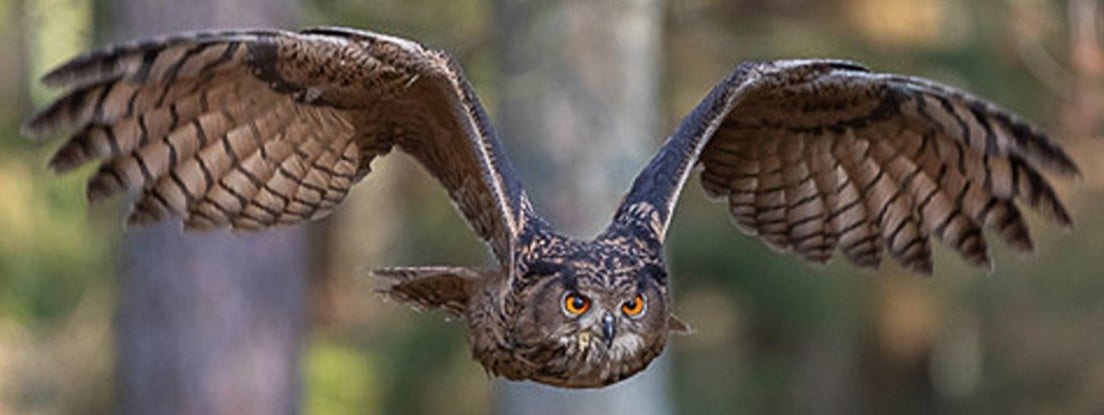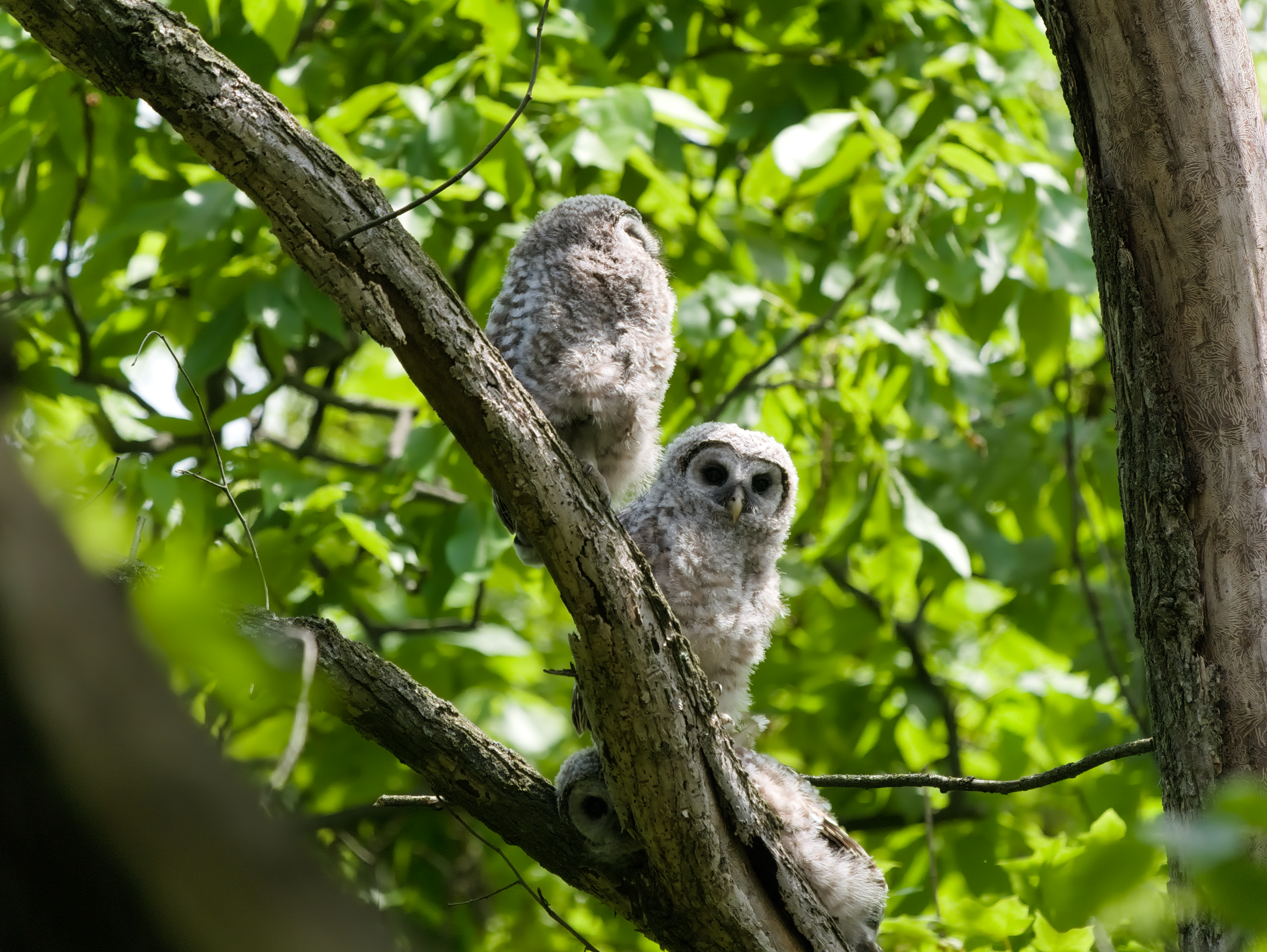My relationship with barred owls began when I built my little cabin in 2002. That first winter a pair hunted from the branches of two large pines situated close to the living room windows. These are large and very beautiful owls with dark luminescent eyes, striped mole and cream feathers and a wingspan up to 50 inches.
I watched for them at dusk, and occasionally witnessed a strike, but most of the time the two peered in at me or just sat there in wait until it got too dark. Of course, with asymmetrical ears that can triangulate exact locations of prey, most meals probably arrived at night. If snow had fallen, I looked for wing prints the following morning though I knew if I saw a pair some creature had lost its life. I reminded myself that owls need to eat too.
As early as December, I would begin to hear barred owl songs. The signature call that most people translate as ‘who cooks for you’ doesn’t work for me. I heard musical trills instead. The pair, they mate for life, frequently vocalized at dusk during the following two months. Their conversation seemed so nuanced and complex. After courting in March or April I heard what I believed to be the territorial hooting call that always seemed louder and more distinct to me.
The parents are excellent caregivers. While the female incubates her 2-3 eggs for a month, the male feeds her. After birth papa brings food for the family until the female can join him hunting. Owlets grow fast and occasionally one will fall out of the nest. Although I never witnessed the sight, some owlets can climb up and down a tree using their beaks and talons! If a chick remains on the ground, one of the parents continues to feed the baby bird until it can fly away.
During the late spring and summer months, I heard owlets call from some hidden branch to let the parent know just where to bring the food! Barred owls eat small mammals, reptiles, amphibians, and insects. The family stays together through autumn, but even after dispersal the young search for territories nearby.
In late spring/early summer it was also common to hear these owls being mobbed by crows and bluejays, and I often followed the cacophony sometimes intercepting the intruders, but most often I witnessed an unhappy owl desperately trying to escape harassment by flying into other heavily protected evergreens. These owls are not aggressive at all – even when they are provoked.
I knew they preferred to nest in old hollow trees or take over corvid,/raptor/squirrel nests, but I never found one. Once I witnessed an owlet perched on an inner hemlock branch. One parent stood watch – two marbled statues. I looked up, riveted by the sight. The fierce and common Great horned owl is their major predator, so it doesn’t surprise me that these birds freeze when observed or hide out as close to the center of a tree as possible to remain invisible.
Barred owls return to the same nesting sites each year. This tendency coincides with research that suggests that they are tied to place. However, in virtually all the literature I have perused these owls prefer ‘old mature forests’ which I most definitely never had but the mountain behind me was probably their sanctuary. Although my woods are composed of the habitat these owls prefer – swamps brook etc. mixed hardwoods and conifers, my land was cut a few years before I moved here.
Time passed. The forests were heavily logged around me (not by the old loggers who were attached to their trees and logged with care) and the pair that lived here disappeared. I did continue to see one roosting in a large hemlock stand on a nearby logging road. When those trees were stripped away, I stopped seeing or hearing barred owls at all.
Then two years ago, I was suddenly serenaded by barred owls one December dusk. I couldn’t believe it. That winter, I heard them calling across the brook. My woods were thriving, the trees had grown, the canopy of evergreens provided good cover, but have a lifetime or two to become ‘mature,’ and besides I own only a fragment, supposedly not enough territory to support barred owls who no longer have stretches of uninterrupted forest to protect them.
For whatever reason, a pair raised a family here last year just as they used to many years ago. If this winter and spring are any indication this same couple may also be raising a family as I write. In the beginning of March, I stood outside for at least 15 minutes around dusk on and off for a week or two to listen to extended muted conversation between one pair. Courting songs.
Then all went quiet for about a month, and now towards the end of April, I sometimes hear a barred owl call during the day with the repetitive territorial call loudest around dusk. Last night owl hooted for over an hour. It was cloudy and still, so I walked down to the swamp and was able to pin-point the location by ear. Sometimes it’s hard to tell.
I wonder if the barred owls that are left are returning to familiar forest fragments that were once a part of larger territories. Privately held patches of land like mine that have been left under nature’s direction and care may have become the only places left that are safe enough for these owls to breed. If my experience is any indication they also may be adapting to smaller territories.
Up until recently, barred owls inhabited portions of the Northeast. But recently their range has extended into the Northwestern part of the United States, and the ‘bird police’ have condemned the intruders as invasive.
The US Inland Fisheries and Wildlife Service and Cornell’s Ornithology Department have determined that the Northwestern expansion of the Barred Owl is threatening the habitat of the its cousin, the spotted owl. The Migratory Bird Treaty Act, the American Bird Conservancy, the Center for Biological Diversity, and some Audubon chapters are also on board with the following decision, which has already been implemented, as of 2025.
Finalized in August 2024, the Barred Owl Management Strategy is the U.S. Fish and Wildlife Service’s long-term plan to ‘protect’ native spotted owls in Washington, Oregon and California from the invasive barred owl species. According to these ‘experts,’ barred owls displace spotted owls, disrupt their nesting, compete for food and in some cases, interbreed with their cousins or kill them.
Ironically, interbreeding means that barred owls and their cousins carry some elements of the same genetic code. Even if the spotted owl disappears when the time is right, the species could return, perhaps in the same or a different form.
The ‘Barred Owl Management Strategy’ permits the lethal removal of barred owls by attracting the owls with recorded calls and then shooting them when they respond and approach. In areas where firearms are not allowed, barred owls can be captured and euthanized by other means.
In all, almost 500, 000 – half a million – barred owls will be killed over the next thirty years because it has been determined by all these organizations that barred owls are disrupting the ecosystem. No one mentions loss of eastern habitat as a reason the barred owls are seeking refuge in the Northwest.
Maine is supposed to be the most heavily forested state, but no one talks about the size of the trees.
The Maine Forest Service’s most recent survey found that only 7.2 percent of trees are in the thirteen to 21-inch diameter, and only 0.5 percent are larger than 21 inches in diameter.
Another way of saying the same thing is to state that ninety plus percent of our forests are full of trees less than a foot in diameter.
We have less than 4 percent of what we now call late successional and old growth(?) forest left in the state. But even more important is that overall, the structural and species biodiversity of our forests is being lost. ‘Mature’ forests are more common (or were up until this point) in the Northwest than in the east.
I don’t believe these owls are invasive. I think barred owls are moving west because they have been forced to by habitat destruction directly caused by humans.
Instead of allowing nature who has been orchestrating life on this planet for 3.7 billion years or more to make the decisions about who lives and who dies when, humans, the youngest species on the planet, believe we have all the answers.
Unlike the common great horned owl, a top predator who seems to be thriving throughout the country, barred owls have a niche that requires trees that provide good canopy cover and swampy areas close to water. These owls are reclusive and cannot breed in the hardwood sticks that are overtaking the mountains of Maine (or future tree plantations that will be cut down as children/adolescents in ‘tree time’).
Animals know. Barred owls are migrating to the Northwest where larger stands of forests still exist because they are trying to survive.






























